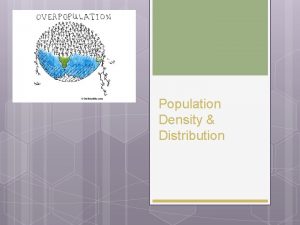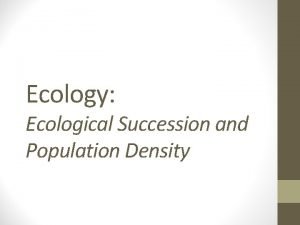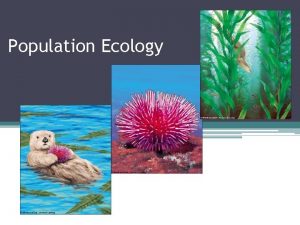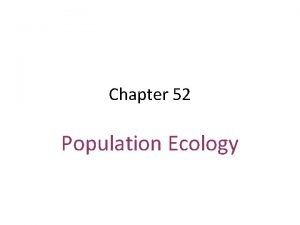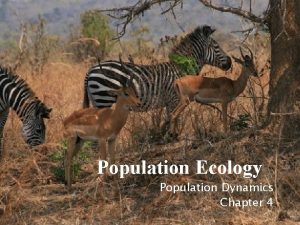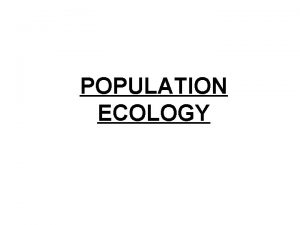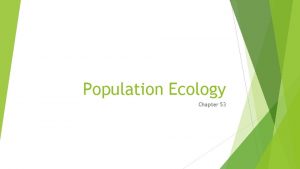Population Ecology Chapter 52 Population characteristics Density of















- Slides: 15

Population Ecology Chapter 52

Population characteristics Density~ # of individuals per unit of area • counts • sample size estimate • indirect indicators • mark-recapture Figure 52. 17

Density is the result of a dynamic interplay ◦ Between processes that add individuals to a population and those that remove individuals from it Births and immigration add individuals to a population. Births Immigration Popu. Iation size Emigration Deaths Figure 52. 2 Deaths and emigration remove individuals from a population.

Population characteristics Dispersion~ pattern of spacing • random~ unpredictable, patternless spacing (a) • clumped~ patchy aggregation (b) • uniform~ even spacing (c)

Demography: factors that affect growth & decline of populations Birthrate (natality)~ # of offspring produced Death Age rate (mortality) structure~ relative number of individuals of each age

Demography: factors that affect growth & decline of populations Survivorship curve~ plot of numbers still alive at each age

The survivorship curve for Belding’s ground squirrels ◦ Shows that the death rate is relatively constant Number of survivors (log scale) 1000 100 Females 10 Males 1 Figure 52. 4 0 2 4 6 Age (years) 8 10

Population Growth Models Zero population growth ◦ Occurs when the birth rate equals the death rate The population growth equation can be expressed as d. N = r. N dt

Population Growth Models Exponential model (red) • idealized population in an unlimited environment (Jcurve) r-selected species (r=per capita growth rate)

The equation of exponential population growth is 2, 000 1, 500 Population size (N) ∆ N= ∆ t rmax. N d. N = 1. 0 N dt 1, 000 500 0 Figure 52. 9 d. N = 0. 5 N dt 0 10 5 Number of generations 15

Population Growth Models Logistic model (blue) • carrying capacity (K): maximum population size that a particular environment can support (Scurve) K-selected species

The logistic growth equation ◦ Includes K, the carrying capacity (K - N ) ∆N = rmax N ∆t K Figure 52. 13 a Number of Paramecium/ml 1, 000 800 600 400 200 0 0 5 10 Time (days) 15 (a) A Paramecium population in the lab. The growth of Paramecium aurelia in small cultures (black dots) closely approximates logistic growth (red curve) if the experimenter maintains a constant environment.

Population life history “strategies” K-selection, or density-dependent selection ◦ Selects for life history traits that are sensitive to population density r-selection, selection or density-independent ◦ Selects for life history traits that maximize reproduction

r-selected K-selected Short Long (opportunistic) maturation & lifespan Many (small) offspring; usually 1 (early) reproduction; no parental care High death rate (equilibrial) maturation & lifespan Few (large) offspring; usually several (late) reproductions; extensive parental care Low death rate

Population limiting factors Density-dependent factors • competition • predation • stress/crowding • waste accumulation Density-independent factors • weather/climate • periodic disturbances
 Chapter 4 population ecology section 1 population dynamics
Chapter 4 population ecology section 1 population dynamics Chapter 4 section 1 population dynamics answer key
Chapter 4 section 1 population dynamics answer key Population ecology section 1 population dynamics
Population ecology section 1 population dynamics Population ecology section 1 population dynamics
Population ecology section 1 population dynamics High arithmetic density
High arithmetic density What is uniform dispersion
What is uniform dispersion Population characteristics
Population characteristics Chapter 53 population ecology
Chapter 53 population ecology Chapter 36 population ecology
Chapter 36 population ecology Ecology
Ecology Chapter 53 population ecology
Chapter 53 population ecology Chapter 4 population ecology answer key
Chapter 4 population ecology answer key Chapter 53 population ecology
Chapter 53 population ecology Clumped dispersion
Clumped dispersion Logistic growth ecology definition
Logistic growth ecology definition Organismal ecology
Organismal ecology
















